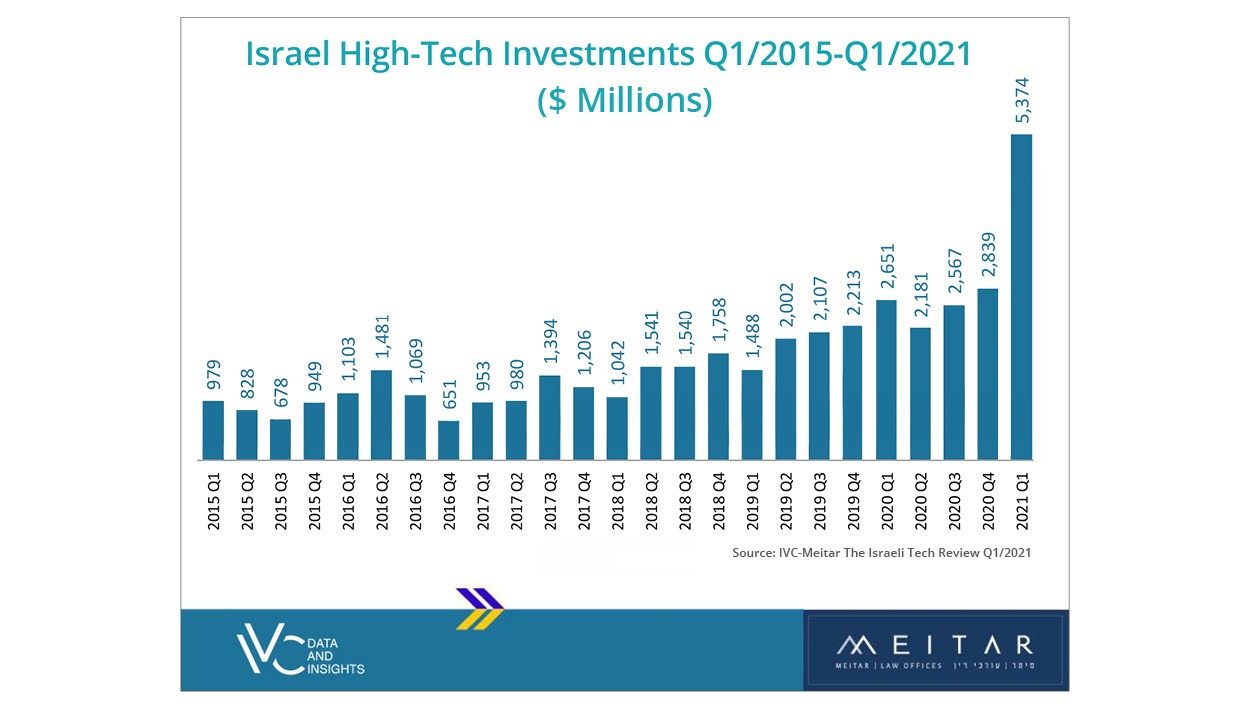by OurCrowd
OurCrowd presented its top ten post-pandemic tech trends on July 13, 2021, broadcasting them live to an audience around the world. With so many changes and challenges during the last year of the pandemic, from shortages of consumer goods to moving life online, the tech industry has been more important than ever in providing creative solutions. It has also been a record-breaking year for venture capital investing, and overall growth in the tech industry.
The online event was based on a popular session of the OurCrowd Global Investor Summit held annually in Jerusalem and which was canceled this year due to the pandemic.
“It’s extremely important this year given the unprecedented growth of the tech investment scene driven by the unbelievable digital transformation that has affected all of our lives,” said Jon Medved, the founder and CEO of OurCrowd, as he opened the event. “There is no better time to analyze what the tech trends are for the smart investor, and where the technology market is moving.”
Many of the ideas and solutions that emerged during the pandemic will be vital even after the virus wanes, Medved said. Several entrepreneurs, industry leaders and OurCrowd investors participated in the event, which was hosted by Alex Roy, a motorsports champion turned tech investor and entrepreneur.
“I’m obsessed with making the impossible possible, and making science fiction, science fact,” Roy said. “The best way to predict the future, is to build the future.”
These are the top ten tech trends:
1. “Work, Pray, Love”: Pivot to virtual
Much of life, including shopping, work and social gatherings, has moved onto the screen, and creative start-up companies are helping to make this shift possible. Even after the pandemic fades, many entrepreneurs and consumers expect much of life to still happen online, or in some combination of in-person and virtually.
“We believe that the world of events is going hybrid,” said Eran Ben-Shushan, co-founder and CEO of Bizzabo, which saw massive growth during the pandemic, even as most in-person events were cancelled.
Other startups fueling this trend include payroll solutions-provider Papaya Global and cybersecurity company JumpCloud, which allows IT managers to track and manage users, devices and platforms on their networks.
2. “Science is for Dinner”: The rise of FoodTech
Lab-produced and plant-based food is disrupting a $6 trillion global food industry. Quality, quantity and sustainability are the driving forces to finding new and alternative sources of food, and better ways to produce food.
“One of the biggest challenges in the food industry is finding alternative protein sources to feed the increasing world population,” said Tammy Meiron, chief technology officer at Israel’s Fresh Start FoodTech Incubator, adding that the market for alternative protein is expected to reach $27 billion by 2027. “We are in a continuous process of a climate crisis that negatively affects crop yields. In addition we have more people to feed with the same land and water resources. We are intensively working on startups that are going to make a revolution in the field. When you bring science into the food, you can create new concepts and flavors.”
Other big players in this field include indoor vertical-farming company Plenty, cell-based seafood products company BlueNalu, alternative dairy products-maker Ripple, and cultured meat startup Aleph Farms.
3. “Retailers Double Down on Digital”: E-commerce
Currently, 60% of customers’ interactions with retailers are online, and companies are leveraging the power of artificial intelligence and augmented reality to ramp up their investments in personalization, location, voice shopping and chat bots.
“COVID-19 forever changed shopping and retail as we know it,” said Andrea Wasserman, head of global commerce at Verizon Media. “Technology that had been nascent in the industry suddenly became a lifeline for survival.”
Wasserman said the challenge now is retaining all the customers who switched to digital shopping during the pandemic. One of the companies helping make that possible is ByondXR, which creates virtual versions of brands’ stores online, where consumers can see products arranged on shelves, and even look out the windows to see views of the streets.
“It’s a platform that brings the best properties of the physical world into the online world, basically creating a perfect harmony between the two,” says ByondXR’s CEO Noam Levavi. Other creative players include personalized advertising startup Clinch and Ordergroove, which focuses on frictionless and ongoing customer experiences.
4. “Water Means Business”: WaterTech
Innovation is improving the safety and availability of the world’s most precious resource, water. Both companies and individuals are benefiting from new and creative solutions.
“What we are seeing today is a new breed of companies which are truly technology companies,” said Eli Nir, a WaterTech investor and OurCrowd partner. “With significant and excellent IT in a range of fields, all the way into AI and cybersecurity, using machine learning to prevent hackers getting into critical water infrastructure.”
Those at the forefront of this trend include BlueGreen Water Technologies, which solves toxic algae growth; IXDen, which protects tiny sensors and other connected devices used on infrastructure from cyber attacks and malfunction; and WINT, which uses artificial intelligence to find and stop leaks at their source.
5. “Logistics are Suddenly Sexy”: Supply Chains
The last year, with shortages in goods ranging from toilet paper to lumber, and the temporary shut-down of the Suez Canal due to a large container ship that ran aground, has highlighted how vital, and vulnerable supply chains are.
“It is clear that supply chains must evolve in efficiency, capacity, agility,” said Ilan Reingold, CEO of BionicHive, which makes robots that can be retrofitted for any warehouse. “There is a strong need to automate and improve the major part of the supply chain that starts at production and ends at the last mile of micro fulfillment.”
Others enabling these needed changes in supply chain logistics include Freightos, an online freight shipping marketplace and Trellis, which uses artificial intelligence and other technology to optimize food and agricultural supply chains.
6. “Data Gets Really, Really Big”: Data
Data is the world’s greatest non-natural resource. Now, new technologies are harnessing its true power to increase understanding about everything from health to materials. It is a field that is impacting every industry and creating new ones.
“They call data ‘the new oil,’ and the reason is because information lets us understand the engine of our world, and how it works,” said Stav Erez, a partner at Jerusalem-based incubator Labs/02. “Data is the main driver of business action in the field of automotive, healthcare, communication, banking, energy, and basically whatever else you can think of.”
Leading companies include Materials Zone, which is speeding up the processes for creating new industrial materials; Dataloop, which helps with the development of vision AI systems; and data.world, which makes platforms to help businesses better use and understand information in order to answer questions and make decisions.
7. “Telemedicine a Day Keeps the Doctor Away”: MedTech/Digital Health
Development like online medical visits and remote monitoring are just the beginning of a huge revolution in healthcare. With technology, care will hopefully get better, more accessible and less costly.
But it’s not just about remote care; the pandemic has also challenged hospitals to take care of patients in safer and more efficient ways. Technology like TytoCare’s handheld examination tool allows doctors to listen to patients’ hearts and lungs while they are at home. During the pandemic, it also came in handy for checking on hospitalized patients without requiring staff to enter the room and potentially be exposed to the virus.
“Nobody thought of using this inside the hospital,” said Eyal Zimlichman, deputy director general, chief medical officer, and chief of innovation at Sheba Medical Center. “But during this COVID crisis, we wanted to have minimal contact between our staff and their patients.”
Other startups driving innovation in medtech include Sweetch, an app that helps patients monitor medical conditions and maintain healthy habits; and Diagnostic Robotics, a triage platform based on artificial intelligence.
8. “Spatial Computing Maps the Future”: Human-Machine Interaction
Artificial intelligence technology is both driving and taking advantage of spatial computing revolution, which will pave the way for more machines interacting with each other and with humans.
“The new wave of computing is spatial, it’s all around us,” said Ori Inbar, an industry expert in augmented and extended reality, referring to the advancement of virtual reality and augmented reality. “We see information in 3D, and it behaves just like real objects behave in the real world.”
Interesting companies in this sector include Edgybees, which overlays situational information over real-time maps and images; volumetric video capturing company TetaVI, and CorrActions, which detects human brain signals, and prevents human error while operating cars and other machines.
9. “Energy Goes Green, Clean, and Lean”: Green Energy
The answer to surging energy demands and sustainability lies in technology. It is something more people are becoming aware of and trying to implement.
“I think there has really been a shift in the way people are thinking about this, partly because while climate change has been a conversation for a long time, it is becoming very real now,” says Kathy Hannun, co-founder and president of Dandelion Energy, which replaces furnaces and air-conditioners with geothermal heat pumps, which use the constant-temperature air found underground to heat or cool a home. The system reduces fossil fuel use and cuts carbon emissions.
Other companies driving this trend include mPrest, a platform that brings artificial intelligence to applications like energy grids and connected cars, and H2PRO, which enables large-scale production of environmentally-friendly hydrogen.
10. ”Quantum Computing Beefs Up, Scales Up, and Shores Up”: Quantum computing
While the long-anticipated advent of quantum computing has been held up by challenges in scalability, programming, and security, solutions are on the way.
“In the last few years it has turned from a dream to reality,” said Nir Minerbi, CEO of Classiq, which is working on algorithms for quantum computers. “And in a few years we will have large-scale quantum computers that will be able to perform tasks that no super computer in the world could have ever done.”
Leading startups pushing quantum computers forward include Entangled Networks, which is working to solve issues of scale; QuantLR, which is developing low-cost cryptography for quantum computers; and Quantum Machines, which makes a universal software and hardware control program for quantum computers.
Bonus Trend! “Cyber Securing the World”
Recent months have seen several high-profile cyber attacks as well as an increase in so-called ransomware attacks, where criminals exhort money. The coronavirus pandemic has led to an overall increased cyber risk, as well as a push for more effective solutions.
“Because of all of the employees that moved to work from home, the threat surface just expanded dramatically,” said Richard Steinnon, an IT security expert. “The security industry saw a bump in spending, and this is probably going to be the best year ever for the cybersecurity industry.”
Related:









